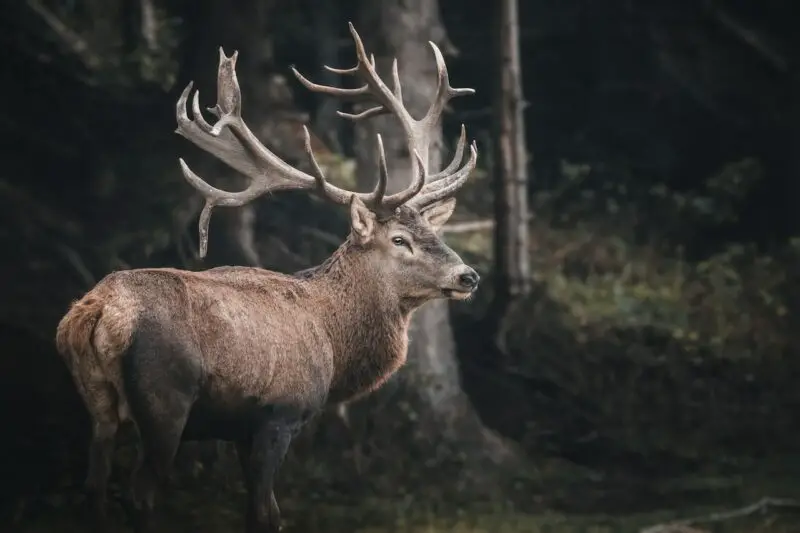Moose and horses are both fascinating animals with their own distinct features. Understanding how they compare in size is a great way to get a sense of their physical differences. By exploring their physical characteristics, habitats, and behavior, we can better appreciate the unique attributes of each animal.
Moose
Moose, also known as elk in Europe, are the largest species of deer in the world. They are primarily found in North America and can be found in forests, swamps, and other wetlands. Moose have long legs and a humped back, which gives them a distinctive appearance.
While horses have been successfully domesticated and are widely used for a variety of purposes, moose have never been successfully domesticated and remain primarily wild animals.
Horse
Horses are domesticated animals that have been bred for various purposes, including riding, racing, and working. They come in various breeds, each with their own distinct characteristics. Horses are found all over the world and are often associated with ranches and farms.
You might think that many wild horses could be found in the Lonestar state of Texas, but the home of the Cowboys doesn’t even crack the top of the list. The top spots belong to Arizona, Nevada, California, and Colorado.
| Category | Moose | Horses |
|---|---|---|
| Size | Much larger: up to 6.9 ft (2.1 m) tall | Smaller: 14 to 17 hands (1.4 to 1.7 m) at shoulder |
| Weight | Up to 1,800 lbs (816 kg) | Up to 2,200 lbs (998 kg) |
| Physical Features | Shaggy coat, large flattened antlers | Smooth coat, long mane and tail, durable hooves |
| Habitat | North America, forests, wetlands | Worldwide, wild and domesticated |
| Diet | Herbivores, eat leaves, twigs, bark | Herbivores, primarily grass and hay |
| Reproduction | Breed in fall, single calf born in spring | Breed year-round, single foal after 11-month gestation |
| Behavior | Solitary, come together during breeding season | Highly social, live in herds |
| Domestication | Never successfully domesticated | Domesticated for various purposes |
| Conservation | Species of least concern | Wild horses considered threatened in some areas |
Comparison of Size
Moose are significantly larger than horses in both height and weight. While horses can range in height from 14 to 17 hands (1.4 to 1.7 meters) at the shoulder, moose can reach up to 6.9 feet (2.1 meters) at the shoulder. In terms of weight, horses can weigh up to 2,200 pounds (998 kg), while moose can weigh up to 1,800 pounds (816 kg).
Height and Weight Differences
Moose are much taller and heavier than horses due to their larger body structure. Moose have longer legs, which allows them to wade through deep water and snow more easily. They also have a humped back and large head, which makes them appear even more massive.
Horses, on the other hand, have a more streamlined body and longer neck. They are built for speed and agility, which is why they are often used for racing and other equestrian sports. While some breeds of horses can be quite tall and heavy, they still pale in comparison to the size of a moose.
Physical Characteristics
Moose and horses have very different physical characteristics. Moose have a shaggy coat that varies in color from dark brown to gray. Their antlers are large and flattened, with several tines that branch off. Male moose, also known as bulls, have larger antlers than females, which they use to defend their territory during mating season.
Horses have smooth coats that can range in color from white to black. Their manes and tails are typically long and flowing, and their hooves are hard and durable. Horses are also known for their large, expressive eyes and their ability to communicate nonverbally with humans.
Habitat and Range
Both moose and horses play important roles in their respective ecosystems, reminding us of the interconnectedness and interdependence of all living beings.
Moose are primarily found in North America, including Alaska, where they can be found in forests, swamps, and other wetlands. They are adaptable animals that can survive in a variety of different habitats, including the tundra and boreal forests. Moose are also known for their ability to swim, and they are often seen wading through lakes and rivers in search of food.
Horses are found all over the world, both in the wild and in domestication. Domesticated horses are typically found on ranches and farms, while wild horses can be found in a variety of habitats, including grasslands, deserts, and forests. The wild horses of North America, known as mustangs, are perhaps the most well-known group of wild horses in the world.
Diet
Moose and horses have very different diets. Moose are herbivores and primarily eat leaves, twigs, and bark. During the winter months, they will also feed on lichen and other types of fungi. Moose have a unique digestive system that allows them to extract nutrients from tough plant material.
Horses are also herbivores and eat a diet that consists primarily of grass and hay. They have a complex digestive system that allows them to extract nutrients from plant material efficiently. Horses require a diet that is high in fiber and low in fat to maintain their health and well-being.
Reproduction and Lifespan
Moose and horses have different reproductive and lifespan characteristics. Moose breed during the fall, and females give birth to a single calf the following spring. Moose calves are born with a reddish-brown coat that helps them blend into their surroundings.
Horses breed year-round, and females typically give birth to a single foal after a gestation period of 11 months. Foals are born with a smooth coat that will change color as they grow older. Horses can live up to 30 years in captivity, while wild horses have shorter lifespans due to the harsh conditions they face in the wild.

Behavior and Socialization
Moose and horses have very different behavior patterns and social structures. Moose are solitary animals and typically only come together during the breeding season. During this time, males will fight for the right to mate with females, and they will use their antlers to defend their territory.
Horses, on the other hand, are highly social animals that live in herds. They have a complex social hierarchy that is based on dominance and submission. Horses use various forms of communication, including body language and vocalizations, to communicate with one another.
Domestication and Use
Horses have been domesticated for thousands of years and have been used for a variety of purposes, including transportation, agriculture, and warfare. Today, horses are primarily used for recreational purposes, including horseback riding, racing, and polo.
Moose, on the other hand, have never been successfully domesticated. While there have been attempts to train moose for use in logging and transportation, they have proven to be difficult to work with and are not well-suited for domestication.
Conservation Status
Moose and horses have different conservation statuses. Moose are considered to be a species of least concern by the International Union for Conservation of Nature (IUCN), which means that they are not currently threatened with extinction. However, some populations of moose have been impacted by habitat loss and hunting.
Wild horses, on the other hand, are considered to be a threatened species in many parts of the world. The mustang population in North America, for example, has been impacted by habitat loss and overgrazing by livestock. There are many organizations dedicated to protecting and conserving wild horses around the world.
Similarities and Differences
In summary, moose and horses are both fascinating animals that have many differences in terms of size, physical characteristics, behavior, and use. While horses have been successfully domesticated and are widely used for a variety of purposes, moose have never been successfully domesticated and remain primarily wild animals.
Conclusion
Understanding the differences between moose and horses is a great way to appreciate the diversity of the animal kingdom. While these two animals may seem similar at first glance, they differ in many ways, from their physical characteristics to their behavior and socialization. Despite these differences, both moose and horses are important animals in their respective ecosystems, and they have played significant roles in human history.
If you are ever wondering how big a moose is compared to a horse, you can now see that the answer is clear. Moose are much larger than horses, and they have a unique set of characteristics that set them apart from other animals. By understanding these differences, you can gain a greater appreciation for these amazing creatures and the role they play in our world.
FAQs
Moose are significantly larger than horses, with adult moose weighing up to 1,500 pounds and standing up to 6 feet tall at the shoulder, while horses typically weigh between 840-2,200 pounds and stand up to 6 feet tall at the shoulder.
Moose and horses are both members of the animal kingdom, but they belong to different taxonomic orders and are not closely related.
Moose have never been successfully domesticated and are not well-suited for riding or other types of work.
Moose and horses have different habitat preferences, with moose typically found in forested areas and horses found in a variety of habitats, including grasslands and deserts.
No, moose and horses cannot interbreed as they belong to different taxonomic families.
- What Size is Regular Printer Paper? Quick Guide for Paper Dimensions - June 18, 2023
- What Size is My Monitor: A Comprehensive Guide - June 18, 2023
- How Big is Italy Compared to the US? A Concise Comparison - June 16, 2023

